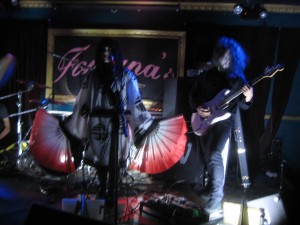Interview with Yamantaka//Sonic Titan
I caught one of Yamantaka//Sonic Titan’s CMJ sets this week at Fontana’s on Wednesday. I then sat down with the group’s two leaders Ruby Kato Attwood and Alaska B at Enid’s in Greenpoint on Thursday. I won’t spend too much time on an introduction since they have plenty to say in their interview, but they are definitely one of the most unique musical acts around and if you ever have a chance, you should see their live show (see the photos for visual evidence!).
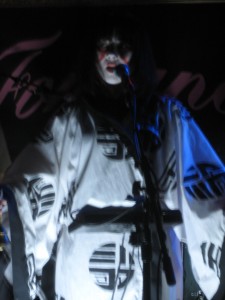 I read that your new album was inspired by Journey to the West. Is that correct?
I read that your new album was inspired by Journey to the West. Is that correct?
Alaska: I would say a lot of things in the band, including on the first album, were inspired by Journey to the West.
I recently saw the musical that was based on that.
Alaska: Oh, the Monkey with Damon Albarn.
Yeah. Did you see it?
Alaska: I’ve seen clips of it.
Ruby: Yeah, I’ve seen clips and stills.
It was pretty cool. Really cool acrobatics.
One of the other things I read was that you were particularly inspired by the two characters of the Monk and the Monkey. So one of you is the Monk and the other is the Monkey?
Ruby: Yes. Alaska is the Monkey. She always wears the Monkey makeup.
Alaska: It’s a stylized version of it.
Ruby: And then I’m always the Monk with the robes.
Alaska: It reflects the character where the Monkey is always action. And I’m playing the drums. And the Monk is always more about speech…
Ruby: And reflection and contemplation and non-action. They’re related to the sun and the moon in the same way. The sun’s this life-giving, chaotic, plasma fireball and the moon is its reflective light. But they are part of the same thing.
I was actually recently at a ceremony where my friend’s father became a monk. It was really interesting.
Alaska: What school?
Korean.
Alaska: Was it Theravada or Mahayana?
I actually don’t know that.
Alaska: Were they ringing bells or were they hitting gongs? That’s one way to tell the difference.
I don’t actually remember either of those things. It was a very simple ceremony.
Ruby: He just accepted the precepts?
Yeah. There was a lot of bowing.
Ruby: Yeah. He had to promise stuff. [Laughter]
So what about the monk lifestyle…
Ruby: I guess we approach those two characters from the position of storytelling. So rather than reflecting necessarily or not necessarily aspects of our true personality, we’re interested in presenting the two opposites and how they’re related through the characters on the stage. There’s aspects of these two opposites of action and reflection or acts of rationality and acts of impulsivity in everybody’s lives. And those poles contain existence. So we’re trying to express those in a more poetic way than something clinical or didactic.
Alaska: And I wouldn’t say that’s the entire basis…
Ruby: No because there are other characters. It’s like a mode.
Alaska: It was kind of a statement about being in America too. So in Journey to the West… I’ve actually been to the Grey Goose pagoda where the story starts, which was a pretty interesting experience for me years ago when I went to China. The characters go to India. And on the Silk Road they run into all the demons and so on because so many people would starve to death, get killed by avalanche, winds, you know, etc. that there’s the concept of there being so many demons. And they learn to get along to go to a strange place to bring back something that brings peace to where they come from. In the same concept, where we’re starting from in North America, it’s in a way going back there to get further here. It’s like going back home even though this is our home here, which is kind of the tongue-in-cheek irony of it all. It was also a statement about– I’m from Alberta. It’s a little bit like–I hate when people say this– it’s kind of like Texas in Canada. And I really hate that because I’ve been to Texas and it’s not really true. But it’s kind of true enough. So for people to foist these stereotypes that they have of people from Asia upon me, being from the most redneck place in Canada, it’s ridiculous because obviously I identify more with the prairies than I do with big, sculpted mountains.
Ruby: And then, as far as it being a starting point, there are all these myths that we came to from that story or in relation to that story also. Different myths about religious figures, leaders, people who go on voyages, expeditions, and just monkeys themselves. There are so many stories about monkeys because they are this animal that’s also sort of human. There are lots of different myths from all over the world about these animal-in-human characters.
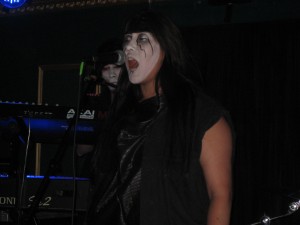 So I know that you draw from a lot of things. You have Chinese and Japanese traditional mythology and you also have North American indigenous mythology.
So I know that you draw from a lot of things. You have Chinese and Japanese traditional mythology and you also have North American indigenous mythology.
Alaska: Yeah. We’ve had a total of three native members so far. Two of the members of our band– one is Iroquois. Our former second drummer– we used to have two drummers in the band, and he was Iroquois as well. And we’ve had Jonas, he’s a guest singer on “One.” He’s also Iroquois. And also our guitarist John is also part indigenous from the Southwest from the border with Mexico.
Ruby: Also Spanish. He has a very long, interesting, convoluted family tree. We’re really interested in personal experiences with culture and self-definition.
Alaska: But also, for us… I’m half Chinese, but I’m also part Mormon. I’m part Swedish, part Irish. I’ve got a very complex background that I also draw on for inspiration. We made a statement about being racialized because all of our influences are Chinese and Japanese and all our other influences are denied. I’ve been to Ireland. I have family from the Southwest in potato country. They still live on farms. And if I were to say that I have all this Irish nationalist influence– Celtic music is a big thing I grew up with– people would be like, “Well, you’re not Irish.” And I would be like, “Yeah, but how many Irish-Americans even listen to Celtic music or know a word of Gaelic.” And I grew up with Gaelic around me. So it’s like, “Fine. You want to paint me with a broad brush. I’ll paint myself with a broad brush.” It’s like, “Give me that brush.” So I think other artists, in particular white American artists can draw influence from anything. They can be like, “Oh. I watched a documentary on National Geographic about Africa and now I’m going to play Afrobeat because I saw a documentary.” And then for us, things that are actually deeply personal– we get told, “Oh, that’s not yours.” So there’s a different imbalance about how people can access different cultures.
Ruby: And in terms of cultural influences, I would say that we’re really influenced by certain art sub-cultures I would say almost even moreso than these ethnic references that we make. Punk music. Performance art. Experimental film. Animation. And drawing, painting. Those kinds of things that are cultural, but not necessarily bound by national identity. And that’s how we work as a multi-media collective, and that’s a huge part of our work as well.
Alaska: My dad was actually a progressive rock musician in the 70s, so that’s where a lot of the progressive rock influence comes from. But that’s something that people wouldn’t necessarily see as being part of my personal influence. People hear it in our music for sure, but you wouldn’t understand that that, for me, is a personal thing. I grew up with the prog records in the house.
Ruby: It’s a bit of a joke.
Alaska: It’s a bit of a tongue-in-cheek thing. I think somebody said once that our entry point is confusion. And I think that’s probably the smartest thing that anybody’s ever said because people want to box things up and instead we made the box really big and then we labeled it with a simple small label that doesn’t describe the box. So, once again, the entry point is confusion.
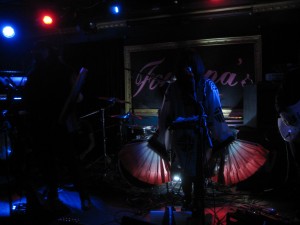 So you call your genre “noh wave” with an “h,” right?
So you call your genre “noh wave” with an “h,” right?
Alaska: Yeah. Honestly, that was just a tongue-in-cheek pun.
Ruby: Yeah. It’s just a little joke.
Alaska: And it’s grown from that. People find it funny. It’s really more like progressive rock.
Ruby: Except that it’s not.
Alaska: Because what does progressive rock even mean?
Ruby: If you talk about prog, we’re nowhere near the musicianship of those bands.
Alaska: Maybe Queensryche. Or Supertramp. [Laughter]
But you’re more interesting than most of them, I would argue.
Alaska: Because we’re more into the aesthetic. The aesthetic is what really interests us. I think one of the biggest disturbances to ourselves is that we really do look at what we do and analyze it, whereas most people just do and they never analyze, and then leave it to others. So I find it funny that because we analyze ourselves and we’re always trying to– I wouldn’t even saying we’re trying to stay ahead of the curve– it just looks like we are. Every different review has some absurdly different description of us. We find it so straightforward.
Ruby: Yes. I think it comes from our relationship with performance art. Because it’s really what you’re taught. Place your physical body in relation to your audience and manipulate that relationship with time and choreography. We came together as artists through performance art, and I think that’s how we approached the band. And that’s not really reflected in the general scope of music.
Alaska: They’re not analyzing it. You know, the white indie guy with the guitar…
Ruby: Analysis is necessary for the relationship between the artist who is making the work and the audience that’s receiving it. That’s a necessary consideration to make. So we made that consideration when we, as Alaska said, decided to paint ourselves with the broad brush. How would we be perceived as this fake crazy rock band that we just dreamed up? What would people see when they saw our faces?
Alaska: It’s like being criticized with no analysis by others. We had a lot of experiences before we started Yamantaka– we’re in art so people are always about symbolism and what things mean, which I find really frustrating because they never actually understand Jungian theory, which is also a whole other discussion about whether or not that’s even legit.
Ruby: And they’re also too busy trying to analyze it so they don’t experience it.
Alaska: So when you do things, they say, “That thing means this thing to me. Therefore, everything you did makes no sense.” And I’ll be like, “Well, you can interpret anything so many different ways. It’s kind of dumb to dig your heels in the ground and say, “This is the only thing it can ever mean.””
Ruby: Cause that’s the way perception works. It’s from a point of view.
Alaska: So for us, if we’re getting critiqued with no analysis, we’d rather make ourselves frustratingly un-critiqueable. In the same way, it’s really easy because you put all these words out there and it’s like, “What do they even mean?” Even when we say, “It’s Chinese and Japanese and native influence,” what does that even mean either? You can’t escape it. Because if you are Chinese or Japanese or native, everything you actually do is going to be Chinese or Japanese or native art. We could just be snapping and it would be Chinese snapping. Because we are redefining anything you do in the moment.
Ruby: Whereas white musicians, you know…
Alaska: Not all, but within the North American cultural paradigm…
Ruby: Those musicians claim, say, for example, blues, as if it isn’t categorized necessarily as black music. It’s just blues, right? It’s not necessarily tied up in their race. However it is obviously, glaringly racial. And that’s what we’re playing on. And the instance we were talking about was actually the use of color– the use of the color white.
Alaska: Yes. In Asia, white is what you wear at funerals. It means that someone is dead. Whereas in western culture it means you’re getting married. But in China, you wear red.
Ruby: So people were debating what it meant. We were representing, or were attempting to represent death– in Japan, the soul is a white butterfly– the soul leaving the body, for example. But this woman in our class was like, “No. You’re a bride.” And we’re like, “No. That’s your opinion.”
Alaska: But they were like, “No. You are a bride.”
Ruby: So we were very intrigued by that container of the mind– how we bring our own biases to art and to the embodied persona, the visual aspect of cultural identity. So then we started taking symbolism and really playing with it, and going, “Look. This is a knife. How does this work in your culture?” So, for example, we’re working with Walter Scott.
Alaska: Who’s Iroquois.
Ruby: Yeah. And he’s a Canadian illustrator and silk-screen artist. Alaska and him were having a lot of dialogues about cross-over in mythology, and it really started growing from there. From what initially was very difficult and about conflict or polemic even became a rhetoric that we could use over and over again to even re-challenge ourselves and say, “Have you made these stereotypes about ninjas or geishas?” And then you do all this research and you see that’s totally wrong. Or Alaska was just telling some stories about her trips to Europe and about preconceived notions she had about Vikings.
Alaska: Yeah. You go to Sweden and there’s one store of Viking junk. They’ve been Christian for so long that they don’t even talk about it.
Ruby: But we’re like, “Sweden! Vikings! Let’s get the swords out!”
Alaska: In the rest of the world it’s like Hagar the Horrible. It’s absurd how we do that. And the same thing with painting anyplace with stereotypes. I think that also as artists, we started out when we were young, and we’ve been working together for eight years now, maybe even a little bit longer. When we started out we had a bit more of a “Chinatown area. Fuck with us, we’ll bury ya” type of attitude. [Laughter] But now instead we’re more in a building-a-thing type of place. You start with deconstructing, smashing the pillars. It’s kind of how Minor Threat evolves into Fugazi. [Laughter] One’s kind of dumb white suburban DC whining and the other’s like, “We’re gonna make some arty music– some real music.”
Ruby: But I think it’s fascinating to just keep coming up against it and keep asking yourself, “What am I doing? Why am I doing this? How do I look at cultural symbols? How do I understand musical genres? And how do I understand that as a musician?” Those are just questions that we’re comfortable with failing at answering. And I think that’s all that we really ask of our fans– or not fans, but just people who are really involved in the scene– is just a self-inquiry and curiosity about symbols instead of just a blatant– letting your mind trick yourself– because it does. We need to judge to live. But you can’t take your judgement at face value because you’re afraid of being wrong or what you don’t know.
Alaska: I also think that when we were starting out, it was also exposing these heavy biases. I played in punk bands. I played keyboard or drums, and I always noticed that the only band that would let me be in it is one that was started by a person of color. The white bands were like, “You don’t look right for our band.” Or the straight bands were like, “You’re too gay. We don’t want you.” There’s always these kinds of attitudes. So for us, it was like, “Let’s make a safe place for us. We’ll start our own band.” Every crappy drummer I knew could get into nine bands, but for me, it was like, “I’ll be your drummer.” And they were like, “No. We’re gonna go with the junkie.” And it was like, “Why? Because they look like you want them to?” And we actually wound up making a Montreal supergroup of all the people of color of the Montreal music scene of the time. They all wound up being in our band at some point. It’s weird how that happened, too. It’s kind of like how Sun Ra was saying, “If you want to talk about black culture, it can’t exist in a colonized world. You have to go to space in order to find your true identity.” So for us too, it was like we’re obviously not going to find our place by struggling to fit into this zone. So it was like, we’ve got to take a step up and be like, “You don’t want us in your party. Well, we’re going to form our own party.” And there was this backlash at the time where after so much crappy treatment, as soon as we started the band, people were like, “Oh, so you won’t let any white people be in your band?” We’re like, “We never even said that. We just started a band.” We had no right to be in anyone else’s, but everyone had a right to be in our band.
Ruby: We had multiple offers of people being like, “I can dress up Chinese too to be in your group.”
Alaska: And I’m like, “I don’t dress up Chinese. I live it.”
Ruby: Honestly, I have to say that some people were kind of mean-spirited about it and it came from a place of feeling excluded.
Alaska: For the first time.
Ruby: Or maybe not. Maybe they were excluded for another reason and this was triggering that or something. And other people just didn’t understand. I think having to go through that and having people that were in your community and even people you really cared about, to say something like that, it was really hurtful. But also you could kind of see the other person, how they were coming from a place of ignorance and their own culture of not having to engage. We just got to a point where it was like, “What are you going to do other than just make your own statement?” And I think beating people over the head or being really heavy-handed or didactic with these things is foolish because it doesn’t work. It’s not fun for anybody. And also because it’s not necessarily accurate. You have to make all of these assumptions about why people are doing what they’re doing. And I think people expressing aggression– not to be relativist– but you don’t know why. You don’t know what they went through. And it’s not necessarily my job to educate people. I have to walk away from situations sometimes. But on the other hand, it’s like, “Do you want to isolate yourself or do you want to engage in a dialogue and live your life?”
Alaska: Just as a disclaimer, our third founding member was white, so there’s never been a point where there wasn’t this broad spectrum. The irony is that everyone boils it down. Even now when we have so many native members and have for years, since we’re the band leaders, everyone always thinks that we’re both Japanese or we’re both Chinese, depending on what they want to see. Some people say I’m a fat virgin: Brooklyn Vegan’s comment section. It’s funny when you give people the bone and you say, “This is where you are. I’ve explained everything to you.” They still throw out 99% of it and they pick what they want to use for what they want.
Ruby: That’s what’s interesting.
Alaska: We’re calling people out. We’re like, “If we don’t talk about our race then you will.” So let’s talk about it. Let’s talk about race so that we can talk about something else.
Alaska: Half-and-half. Half of us are in Montreal.
So do you all speak French too?
Alaska: Un peu.
Ruby: Yeah. I speak French.
But neither of you are from a French-speaking background?
Ruby: No.
So what brought you to Montreal?
Alaska: I’m from a rough oil town. After I finished high school I was looking at moving into a $200 apartment in Chinatown where people kick down your doors and steal all your shit every three days. And I applied to Concordia’s experimental electro-acoustic music studies on a random thing because I didn’t really do the best in high school. It was my ticket out of there. It was the one school that accepted me. And I went, “Fuck this place,” and just jetted. Being a queer kid in the prairie– a queer kid of color– isn’t really the best place to grow up or to try to make a life for yourself. So I took off the first chance that I could.
Ruby: I was in a similar situation. I’m from a rural area, but I wanted something more exciting. My extended family lived in Toronto, but I didn’t really want to go to school there. I didn’t have any interest in any of the university options that were available. I visited Montreal a few times and I was really enamored with the culture. The city really felt like a smaller town because the Anglophone scene is quite small. But the city was large, so I sort of felt like it was the best of both worlds. I started at Concordia in religious studies actually, studying Christianity and Judaism. And I switched to fine arts after two years.
Alaska: Oh yeah. I didn’t finish my music studies program. I transferred to fine arts.
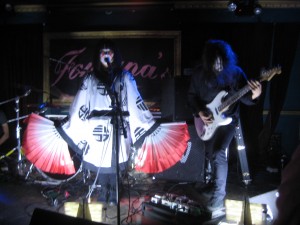 And are you still studying computer animation?
And are you still studying computer animation?
Alaska: I did take it. I was at Sheridan College. It’s one of the top computer animation schools. They’re gonna love me if they hear me say that. Actually the band blew up when I was in that class. It’s a one-year intensive of two or three years of school. So I wound up getting in tons of shit for skipping class to play at All Tomorrow’s Parties. But it was worth it.
You did this rock opera 33. That was last year?
Ruby: Yeah.
Did you use any of that material on your new album?
Alaska: Yes. The beginning of side two: “Seasickness One” and “Seasickness Part Two.” They are the first act of 33.
And that is about drag queens?
Alaska: Yes.
Ruby: It’s also sort of about reincarnation and death and religion.
Alaska: And also about losing relevance. And, as you age– young people have all these ideas about what their lives are going to be. Like “Oh, this is a cool neighborhood” or “Oh, this is a cool venue.” And as you age, you realize you’re being replaced by younger cooler people. There are people who are more on top of what’s cool than you are. And you don’t want to be that 40 year old who’s still hanging out with 20 year olds.
Ruby: So you have to face your inner demons.
Alaska: And you have to be like, “What’s really important in my life? What do I really want to do with myself?” Which is funny because we’re living in Montreal where nobody ever really grows up. Sometimes we watch Portlandia and we’re like, “Oh. It’s just an English Montreal.”
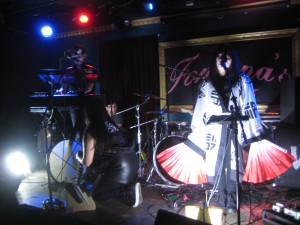 You also put out a collaboration with Fucked Up. That was last year as well, right?
You also put out a collaboration with Fucked Up. That was last year as well, right?
Alaska: Yeah. I’m friends with Damian.
Ruby: They’re sweethearts.
Alaska: I haven’t seen them in a year. I actually used to live down the street from Damian. He’s so busy we never see each other.
I’ve seen them live and they’re so much fun.
Alaska: Yeah. One time someone in the crowd threw a beach ball and Damian punched a hole in the beach ball and put his head in it. [Laughter] He climbed in it.
Ruby: We really appreciate that kind of ad-libbing so to speak. He can just roll with it. He’s a really funny guy.
Alaska: I had been on guest lists of Fucked Up shows for a year, but I was always that person smoking pot in the back when they were playing and listening through the windows. I actually don’t like being in the audience of really intense shows anymore. I used to go to death metal shows and shit all the time when I was younger. And I just find I get too anxious in the testosterone-addled fist-pumping crowd.
Ruby: I’m too short.
Alaska: Yeah. You can’t see anything.
Ruby: Can’t handle it.
Alaska: I would just get trapped all the time. I got tired of it. I was kind of a street punk when I was a teenager and I was like, “I’m getting bored of this.” So I only wound up seeing them live for real years later.
One of the things he said when I saw them live was that the essence of punk rock is just “Start your own band. Even if you don’t know how to play any of the instruments. Just do it.”
Ruby: Yes. Totally.
I thought that was very cool.
Ruby: Yeah. It’s very nirvana I think.
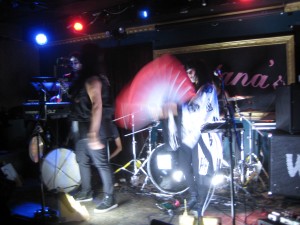 I’ve heard you talk about Kiss as an influence for your makeup.
I’ve heard you talk about Kiss as an influence for your makeup.
Alaska: Yeah. It wasn’t the original reason. Because when we started out we would do the Butoh white face thing. And sometimes we would play without makeup.
Ruby: And one of our original full-installation opera performances was only masks. And a second iteration of it had makeup. But we’re not going to deny that we love Kiss.
Alaska: The best Kiss story is that we were on tour and this guy who reviewed us was just a total shit and he was like, “They’re so pretentious, I bet they don’t even like Kiss. Or they wouldn’t even admit that they like Kiss if they did.” And we were laughing because we were like, “Yeah. Whatever.” We were kind of bummed cause we were on the long drive in the desert to get to Texas from California and we didn’t actually have any shows booked.
Ruby: And we were watching money getting sucked into the van.
Alaska: We pulled into this town of Alpine, Texas at this Holiday Inn in an almost completely empty parking lot and I pull out of the passenger door. And right on the ground is a copy of Kiss’s Destroyer. Just the CD. No case. Nothing. I pick it up and it’s scratched to shit and I’m like, “The metal gods must be shining on us today.” [Laughter] So we took it inside and didn’t think much about it. And the next day we put the CD in and it played perfectly. No skips. And every other CD we ever put in skipped. We drove all the way to the next town listening to the entirety of Kiss’s Destroyer. And then the CD got lost the next day. We didn’t see it again. And we were like, “That’s really weird.”
Ruby: So we take it as a sign.
Alaska: And Kiss released a new record. So I kind of wonder if they saw us and were like, “We’ve gotta put out a new record, guys.” [Laughter]
You build your own musical instruments.
Alaska: We used to use them more. We don’t use them as much now on the road. I’ve only been slowly getting better at making them durable. We have a shamisen that I built with my friend several years ago. When we first met I had built a tambura out of guitar parts and a megaphone that actually could play out of itself with pickups and everything.
Ruby: We have some more simpler designs. We have one that’s a water chestnut can in a guitar neck with four strings. It’s kind of like a koto.
Alaska: No. It’s more like a shamisen. And I built a guzheng– like a koto in Japan– but guzheng in Chinese, which is a kind of zither. We built our own with five bucks worth of wood and nails.
Ruby: But they’re not durable. You can’t tour with it. That was really when we were influenced a lot more by experimental music and noise music, artists who were building sound sculptures, and stuff like that. It wasn’t meant to be permanent, but it was really influential because of the hybrid form.
Alaska: At the time we started I was also building electronic drums out of parts that I found. And our first shows didn’t have acoustic drums except for cymbals. Now most of the time building instruments has been dedicated to building our lighting systems. Now I do a bit of that, some synth modification repairs, and then I apply the skills to the recording, engineering, mixing of our record. I do all that mostly by myself with people we hire and some of our own band members. So we apply the skills even though we don’t tend to take them on the road.
Ruby: It’s just not practical.
Alaska: Everybody’s got their specific instruments that they play now. Back in the day, we had a second drummer, so I could actually go and play an instrument I built. And when you build your own instrument you’re usually really the only one who knows how to play it. So, we don’t really use them as much. And I’m open to admitting that.
Ruby: However, the first time Alaska and I really connected was when I played one of her instruments quite well actually. We hadn’t really even spoken very much, and she presented it as a sculpture in class and really everyone was like, “What is that pile of crap?” Because it really looked like a pile of garbage all soldered together. And she was like, “It’s a musical instrument.” And I just grabbed it and tried it. And really just tried to listen and engage. And we connected on that element of openness.
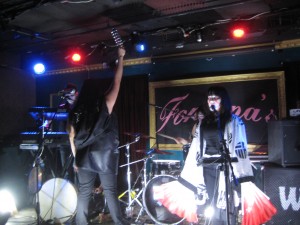 Have you had any time, or will you have any time, to catch any of the other shows at CMJ?
Have you had any time, or will you have any time, to catch any of the other shows at CMJ?
Ruby: Oh man. No.
Alaska: We never do. I’ve seen some neat stuff right before or right after. We’ve even been playing on the same bill last night as someone that I wanted to see, but we had to leave and go somewhere else. We really don’t have enough time, especially with our light system– we have be constantly modifying and repairing it.
Ruby: And most people would be using this moment to plug their friends’ bands, but we’re just telling the truth, which is that we play all these shows and have to travel and we don’t get to have any fun.
Alaska: But I think we might get to see Omar Souleyman.
Ruby: Yes! Which is pretty exciting.
Alaska: I think we play right after him. We’ve seen a lot of great bands– say, at All Tomorrow’s Parties. We got to see Group Doueh, which was amazing.
When was that?
Alaska: That was early last year. We got to see The Boredoms.
Ruby: It was amazing. The Boredoms, Group Doueh and Sun Ra. All in the span of two days. It was great!
By Jesse Brent
